Mechanisms of connecting tubule glomerular feedback enhancement by aldosterone
- PMID: 27413197
- PMCID: PMC5210193
- DOI: 10.1152/ajprenal.00076.2016
Mechanisms of connecting tubule glomerular feedback enhancement by aldosterone
Abstract
Connecting tubule glomerular feedback (CTGF) is a mechanism where an increase in sodium (Na) concentration in the connecting tubule (CNT) causes the afferent arteriole (Af-Art) to dilate. We recently reported that aldosterone within the CNT lumen enhances CTGF via a nongenomic effect involving GPR30 receptors and sodium/hydrogen exchanger (NHE), but the signaling pathways of this mechanism are unknown. We hypothesize that aldosterone enhances CTGF via cAMP/protein kinase A (PKA) pathway that activates protein kinase C (PKC) and stimulates superoxide (O2-) production. Rabbit Af-Arts and their adherent CNTs were microdissected and simultaneously perfused. Two consecutive CTGF curves were elicited by increasing the CNT luminal NaCl. We found that the main effect of aldosterone was to sensitize CTGF and we analyzed data by comparing NaCl concentration in the CNT perfusate needed to achieve half of the maximal response (EC50). During the control period, the NaCl concentration that elicited a half-maximal response (EC50) was 37.0 ± 2.0 mmol/l; addition of aldosterone (10-8 mol/l) to the CNT lumen decreased EC50 to 19.3 ± 1.3 mmol/l (P ≤ 0.001 vs. Control). The specific adenylyl cyclase inhibitor 2',3'-dideoxyadenosine (ddA; 2 × 10-4 mol/l) and the PKA inhibitor H-89 dihydrochloride hydrate (H-89; 2 × 10-6 mol/l) prevented the aldosterone effect. The selective PKC inhibitor GF109203X (10-8 mol/l) also prevented EC50 reduction caused by aldosterone. CNT intraluminal addition of O2- scavenger tempol (10-4 mol/l) blocked the aldosterone effect. We conclude that aldosterone inside the CNT lumen enhances CTGF via a cAMP/PKA/PKC pathway and stimulates O2- generation and this process may contribute to renal damage by increasing glomerular capillary pressure.
Keywords: PKA inhibitor; arterioles; distal kidney tubules; superoxide.
Copyright © 2016 the American Physiological Society.
Figures

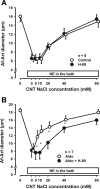
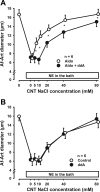
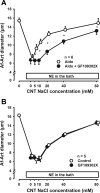
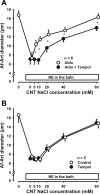
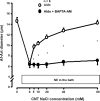

References
-
- Barajas L, Powers K, Carretero OA, Scicli AG, Inagami T. Immunocytochemical localization of renin and kallikrein in the rat renal cortex. Kidney Int 29: 965–970, 1986. - PubMed
-
- Christ M, Gunther A, Heck M, Schmidt BM, Falkenstein E, Wehling M. Aldosterone, not estradiol, is the physiological agonist for rapid increases in cAMP in vascular smooth muscle cells. Circulation 99: 1485–1491, 1999. - PubMed
-
- Christ M, Meyer C, Sippel K, Wehling M. Rapid aldosterone signaling in vascular smooth muscle cells: involvement of phospholipase C, diacylglycerol and protein kinase C. Biochem Biophys Res Commun 213: 123–129, 1995. - PubMed
-
- Doolan CM, Harvey BJ. Modulation of cytosolic protein kinase C and calcium ion activity by steroid hormones in rat distal colon. J Biol Chem 271: 8763–8767, 1996. - PubMed
Publication types
MeSH terms
Substances
Grants and funding
LinkOut - more resources
Full Text Sources
Other Literature Sources
Miscellaneous

